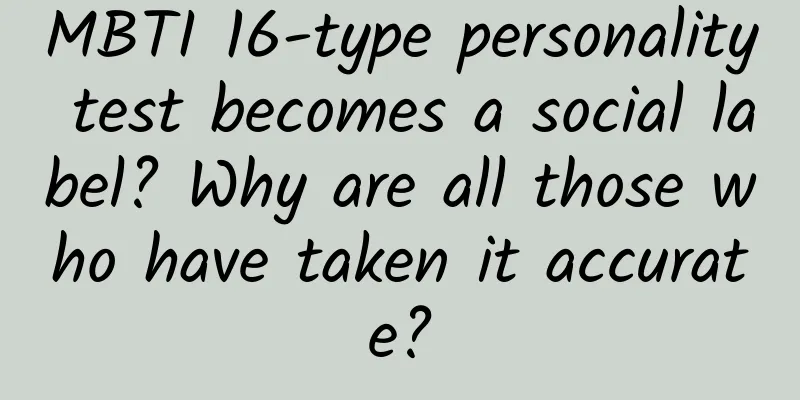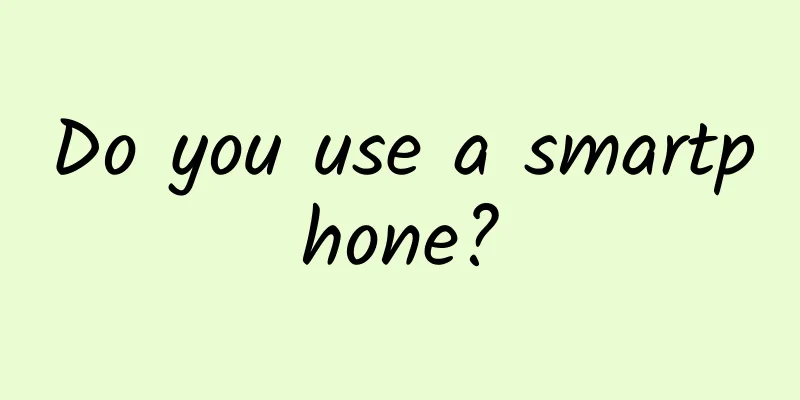MBTI 16-type personality test becomes a social label? Why are all those who have taken it accurate?

|
When you read other people’s self-introductions on social platforms such as Zhihu, Summer, and Soul, you will often see similar four-letter combinations such as ENTJ, INTJ, ISTP, etc., listed together with their careers, hobbies, etc. Those who don’t understand will be confused, while those who do understand may quickly resonate with it: “Ah, so you have this kind of personality too.” Gu Ailing once took this world-famous 16-personality test and called herself an "introvert." Image from Weibo @智族GQ What is MBTI? And what does INTJ mean in Gu Ailing's words? What is MBTI MBTI, the full name of Myers–Briggs Type Indicator, is a personality testing tool, translated as Myers-Briggs Type Indicator. This indicator defines the way people perceive the world through four dimensions: attention direction (source of energy), cognitive style (collecting information), judgment style (decision-making style), and lifestyle (coping with the external world), and judges people's personality types based on this. Image source: hippopx According to the subjects' answers, there will be different tendencies in the following four dimensions, and thus they can be divided into two types in each dimension. 1. Extroversion or introversion (E or I), this characteristic is more obvious in the social field. Extroverts are often the focus of attention in social activities such as classmates, colleagues gatherings, company events, etc. They are usually the ones who start topics and constantly guide conversations. They are good at expressing their own opinions, but may not be good at listening. This type of people prefer to convey their ideas to others, so as to gain energy from constant communication. Introverts are just the opposite. They don't like to attract attention, are relatively passive in social situations, and seem unwilling or not good at speaking. They are usually not good at expressing their own ideas or leading a conversation, but on the contrary they prefer to listen to ideas and suggestions, and prefer to be alone than extroverts. 2. Insight or intuition (S or N). This characteristic is reflected in the obvious bifurcation in the perspectives on the problem. Among them, people of the perceiving type are very sensitive to changes in the surrounding environment, believe in certain and tangible things, and focus on reality. They are more realistic in dealing with problems and will decide their own action strategies based on actual challenges when facing the future. Intuitive people trust their feelings more, attach more importance to possibility and originality, like to learn new skills, and are more interested in the overall overview and universal laws of things. They focus on the future and pay attention to the changing trends of things. 3. Thinking or Feeling (T or F). These two personality traits are generally manifested in different ways of dealing with problems. Among them, people with the thinking type are more logical, good at discovering connections between things, and using logic to solve problems. Emotional people are usually more sentimental. When making decisions, they consider more the emotional experience that the decision may bring to others. They are more humane and tend to put emotions first and reason second when dealing with problems. 4. Judgment or perception (J or P), which is specifically reflected in the difference in behavior style. People with the Judging type have a rigorous attitude towards life, are meticulous in their work, have a strong sense of purpose, have more detailed work or life plans and strictly implement them. Perceiving people tend to live a more casual life. They don't have any fixed plans for doing things and just do whatever they think of. However, they usually have more flexible thinking and are more adaptable to the environment. According to the letters corresponding to the preference types in each of the above four dimensions, each person's personality type can be formed, namely: ESFP, ISFP, ENFJ, ENFP, ESTP, ISTP, INFJ, INFP, ESFJ, ISFJ, ENTP, INTP, ESTJ, ISTJ, ENTJ, INTJ. 16 MBTI personality types, image source: Wikipedia Of course, all test results can only show that your personality has a tendency in a certain dimension, and the degree of tendency varies from person to person. Even if the test results of two people are the same, it does not mean that their personalities are exactly the same. The origins of MBTI In 1917, American psychologist Cairnlyn Cook Briggs studied on her own and read a large number of celebrity biographies, gradually developing a "four personality theory". In 1927, she launched her own theory based on Jung's book "Psychological Types" and published articles on the basic knowledge of the theory. Later, her daughter also participated in this work, and through methods such as testing, statistical analysis and data verification, the Myers-Briggs Type Indicator was launched in 1944. Cailin Cook Briggs and her daughter, Image source: Wikipedia However, after the launch of MBTI, it has been controversial. Some people think it is too subjective, has user bias, and lacks falsification. However, for now, MBTI is still the most popular personality test method in the world. Is MBTI accurate? Some psychologists believe that this test is not very reliable because many people taking this test at different times will get completely different results due to changing factors such as the subject's mood and environment. In addition, the conclusions obtained through MBTI cannot avoid the "Barnum effect" (a psychological phenomenon in which people give highly accurate evaluations of personality descriptions that they believe are tailor-made for themselves, and these descriptions are often very vague and general, so that they can be applied universally to many people.), which means that the evaluations you see are all mixed with Barnum's statements. In addition, when taking the test, since the test is in the form of self-assessment, each person's understanding of themselves includes both the real part and the part they expect. Therefore, personality tests cannot fully, accurately and objectively reflect the real self, and many studies have shown that people who are keen on various personality tests are often curious about themselves and want to know more about themselves. From a scientific point of view, there are many versions of MBTI, and the validity of each version is different. Moreover, the measurement results of MBTI are not 100% accurate, but it is not metaphysics either. Because its questions are designed based on the observation and induction of human cognitive methods, and psychology studies human psychology through human behavior. Therefore, through your daily behavior and answers to certain questions, it can indeed help you better understand yourself and others. Therefore, we should take a critical attitude towards the test results of MBTI. We should neither over-trust nor over-reject. MBTI is a tool for us to understand ourselves and others. The complexity of human beings is far beyond what can be summarized by the few dimensions mentioned above, so we must look at the results objectively. Through the MBTI test results, we can discover our own strengths and continuously strengthen them, then make up for our own weaknesses, and constantly improve ourselves by understanding ourselves better. This is the meaning of MBTI! END Review expert: Taozi, national psychological counselor. Tadpole Musical Notation original article, please indicate the source when reprinting Editor/Xiao Xitushuo |
<<: Stop hoarding food! Someone has already gotten into trouble!
>>: If you feel uncomfortable, please put down your phone! These messages are silently causing harm
Recommend
The carotene content of broccoli is 29 times that of broccoli! This vegetable is antioxidant, promotes bowel movements, and controls blood pressure. It would be a pity to miss it.
When it comes to kale, many people only think of ...
Kuaishou short video advertising creativity and problem analysis
With the rise of short videos, mainstream short v...
My hair is falling out and my leg hair is growing. Who knows the pain of being teased as a "kiwi fruit" or a "yam stick"!
Why do some people have more body hair and some h...
How much does Baidu promotion cost? How to calculate Baidu promotion cost?
It depends on the specific word being promoted. T...
What is Momo? King of Glory is the biggest hookup platform in China!
Yes, Honor of Kings , a mobile game , seems to ha...
Neuroscience tells you: How to cultivate user habits?
As Internet business matures, it has become a con...
2022 Chengdu Tea Drinking Resource Group Tea Drinking and Tasting Best
Appointment arrangements for the Chengdu tea drin...
Foreign dramas are restricted: self-produced dramas and TV series have new opportunities
After the removal of four popular American TV ser...
A complete operation and promotion plan for an App!
1. Concept of App operation and promotion Quoting...
WeChat 8.0 is awesome! But it's fatter
[[377737]] On January 21, 2021, WeChat celebrated...
Lei Jun proposed "changing the license plate" at the two sessions. Do you want to change the green license plate on your car?
In 2025, data from various sources show that the ...
If we cut off the free live broadcasts, do we still need a TV in the living room?
Popular Science Times reporter Chen Jie Recently,...
How does WeChat Reading achieve user fission?
More and more people in the circle of friends hav...
Chun Shui Tang, the "Xiaomi doll" brand: with a price of 2999, the quality is comparable to that of silicone dolls worth tens of thousands of yuan
Humans seem to have an innate love for puppets. I...









